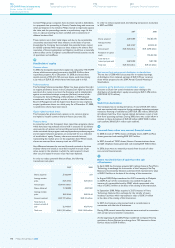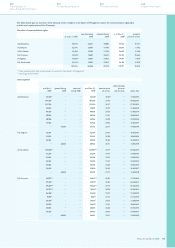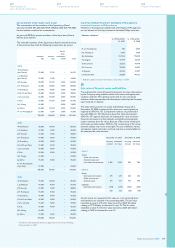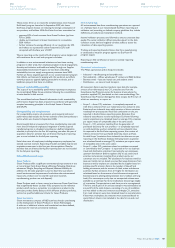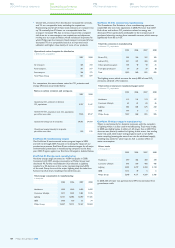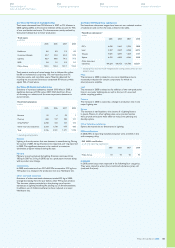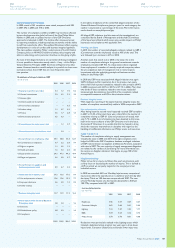Philips 2008 Annual Report Download - page 180
Download and view the complete annual report
Please find page 180 of the 2008 Philips annual report below. You can navigate through the pages in the report by either clicking on the pages listed below, or by using the keyword search tool below to find specific information within the annual report.
Sustainability
performance
Launched in 1959 as an internal event intended to help researchers
from different labs find synergies in their work, in 2001 Philips
businesses began bringing strategic customers to CRE and extending
invitations to other key external stakeholders in the following years.
Material issues and our focus
Based on our trend analysis and stakeholder input, we identify the
key material issues for our company. Using the materiality matrix
approach, we have mapped relevant issues on a scale from low to
high in terms of the:
level of concern to society at large and stakeholders, versus
•
impact on Philips, or
level of control or influence we can have on an issue through
•
our operations and products/solutions.
This is a dynamic process, as we continuously monitor the world
around us. Currently we consider the following items as material,
making a distinction between clear risks and opportunities.
Key material issues
opportunity risk
Health
Rising healthcare costs -
Chronic diseases in developing world -
Lack of access to affordable healthcare -
Infectious diseases in developing world -
Employee health and safety -
✓
✓
✓
✓
✓
Business
Demand and credit crisis -
Offshoring/outsourcing -
Business integrity -
✓
✓
✓
Societal
Aging population in developed world -
Rising attention for human rights -
✓
✓
Environmental
Climate change -
Energy management -
Clean technologies -
Collection and recycling -
✓
✓
✓
✓
✓
Based on this, we develop our strategy and vision, as well as the
programs and policies to drive the implementation of our strategy.
Our primary focus has been on business opportunities in energy
efficiency and healthcare. We also have programs in place to manage
risk, including our General Business Principles, Sustainability Policies
and Supplier Sustainability Involvement Program.
Sustainability programs and targets
All of our programs are guided by the Philips General Business
Principles, which provide the fundamental principles for all of our
business decisions and actions.
With our longstanding commitment to reducing the environmental
impact of our products and processes, we have been establishing
four-year action programs with measurable targets since 1994.
We are currently running two programs – EcoVision III, which covers
the years 2006-2009, and EcoVision4, which runs through 2012.
EcoVision III is focused primarily on reducing the environmental
footprint of our manufacturing processes spanning a broad range
of parameters (full details on the program can be found at
www.philips.com/sustainability). After EcoVision III was launched in
2005, two major developments affected the scope and relevance of
this program. Internally, the divestment of our Semiconductors sector
in September 2006 significantly reduced the overall environmental
impact of most of the program’s parameters. Outside the company,
the issue of energy efficiency emerged strongly at the global level.
Philips Annual Report 2008180
180
Sustainability performance
Approach to sustainability reporting
192
IFRS financial statements
244
Company financial statements
124
US GAAP financial statements
Approach to sustainability reporting
In 1999 we published our first environmental annual report.
We expanded our reporting in 2003 with the launch of our first
sustainability annual report, which provided details on our social and
economic performance in addition to our environmental results.
Now, for the first time, Philips is reporting on its annual financial,
social and environmental performance in a single, integrated report.
This approach reflects the progress we have made to embed
sustainability in our way of doing business.
Reporting standards
In compiling the sustainability performance covered in this report,
we have followed relevant best practice standards and international
guidelines. Most important are the Global Reporting Initiative’s (GRI)
G3 Sustainability Reporting Guidelines.
In keeping with G3 we have sharpened our focus on the principles
of materiality, stakeholder inclusiveness, sustainability context and
completeness. As a result, with regard to the GRI Application Levels
system, we see ourselves currently positioned at the B+ level. We
cover a large part of the G3 Core Indicators, while our Management
Approach is explained in this report and in our previous sustainability
reports. A detailed overview of these Core Indicators is provided at
the end of this section.
We signed on to the United Nations Global Compact in March
2007, joining thousands of companies from all regions of the world,
international labor and civil society organizations to advance
10 universal principles in the areas of human rights, labor, the
environment and anti-corruption. Our General Business Principles,
Sustainability and Environmental Policies, and our Supplier Sustainability
Declaration are the cornerstones that enable us to live up to the
standards set by the Global Compact. This is closely monitored and
reported, as illustrated throughout this report.
Trends
We continuously follow external trends to determine the issues most
relevant for our company and those where we can make a positive
contribution to society at large. In addition to our own research, we
make use of a variety of sources, including the World Bank, World
Business Council for Sustainable Development, World Economic
Forum and World Health Organization. As a member of organizations
like the World Business Council for Sustainable Development and the
Electronic Industry Code of Conduct, we participate in meetings and
task forces, bringing new learning to bear. Our work also involves
tracking topics of concern to governments, regulatory bodies and
non-governmental organizations, and following the resulting
media coverage.
Stakeholder input on innovations
We also engage directly with stakeholders to gain additional outside
perspective. One of the most important platforms is our Sustainability
Innovation Day held during our annual Corporate Research
Exhibition (CRE).
At the 2008 CRE in May stakeholders from governmental and
non-governmental organizations viewed our innovations designed
to meet the global energy and climate change challenge as well as
other environmental topics. The event was designed to encourage
participants to listen to each other and begin an ongoing dialogue to
envision innovative solutions to these challenges. They learned about
projects on zero standby power, Organic LEDs, green urban living,
air quality sensing and the Compact UV for safe drinking water,
among others.


